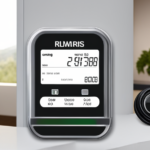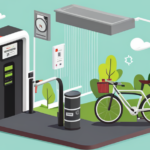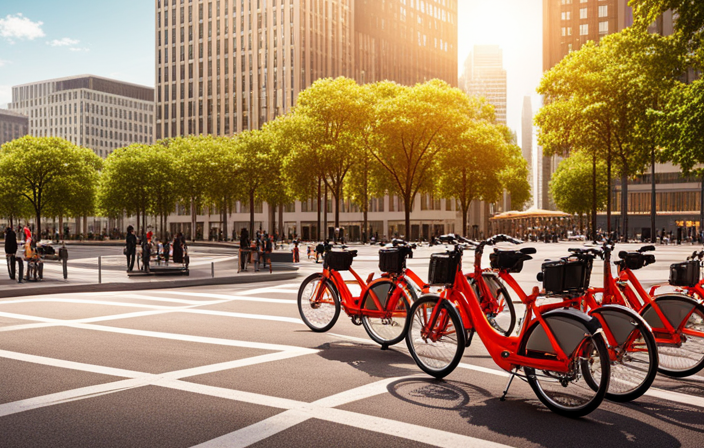I’ve always been curious about the cost of charging my electric bike. The answer is not as simple as you may anticipate.
It depends on factors like electricity rates in your area, the battery capacity of your bike, and the frequency of charging.
In this article, we’ll dive deep into the nitty-gritty details of electric bike charging costs. From energy efficiency to government incentives, we’ll explore all the factors that play a role in determining how much it truly costs to keep your electric bike charged and ready to go.
Key Takeaways
- Electricity rates and cost of charging can vary depending on location and time of use.
- Government incentives and rebates may help offset the cost of charging an electric bike.
- Charging at home is usually more cost-effective than charging at public stations.
- Off-peak charging can result in cost savings due to lower electricity rates.
Electricity Rates in Your Area
You should check the electricity rates in your area to determine how much it will cost to charge your electric bike. The electricity rates can vary depending on where you live, so it’s important to do some research to find out the exact cost.
To calculate the cost, you need to know the electricity consumption of your electric bike. This can usually be found in the user manual or by contacting the manufacturer. Once you have this information, you can multiply the electricity consumption by the cost per kilowatt-hour in your area to determine the cost of charging your electric bike.
Additionally, it’s worth considering the availability of charging infrastructure in your area. If there are charging stations nearby, you may have the option to charge your electric bike for free or at a lower cost than charging at home. It’s important to take into account both the electricity rates and the charging infrastructure availability when calculating the cost of charging your electric bike.
Now that you have an idea of the electricity rates in your area, let’s move on to the next section and discuss the battery capacity of your electric bike.
Battery Capacity of Your Electric Bike
To determine the battery capacity of your e-bike, check the specifications provided by the manufacturer. This information is crucial for understanding how much power your e-bike can store and how far it can take you on a single charge. Battery capacity is typically measured in watt-hours (Wh) and can vary depending on the model and brand of your e-bike. It is important to note that the battery capacity will directly impact the range of your e-bike, so it is essential to choose a battery with sufficient capacity to meet your needs.
Battery maintenance plays a vital role in ensuring the longevity and performance of your e-bike’s battery. Regularly checking the battery’s charge level, avoiding extreme temperatures, and using the recommended charger are essential for extending the battery’s lifespan. Additionally, it is important to follow the manufacturer’s guidelines for battery care and storage to prevent any potential damage.
Having a reliable charging infrastructure is key to keeping your e-bike’s battery charged and ready to go. It is crucial to have access to charging stations or outlets that are compatible with your e-bike’s charger. This ensures that you can conveniently charge your e-bike wherever you go, whether it’s at home, work, or on the road.
Understanding the battery capacity of your e-bike and maintaining its battery properly are crucial for maximizing its performance and lifespan. Next, let’s discuss the charging time required to fully charge your e-bike’s battery.
Charging Time Required
Determining the charging time required for my e-bike’s battery is crucial for planning my rides and ensuring that my battery is always ready to go. The charging speed of electric bikes can vary depending on several factors. Here are three key factors that affect the charging time:
-
Battery Capacity: The larger the battery capacity, the longer it will take to charge. A higher capacity battery may take several hours to fully charge, while a smaller capacity battery can be charged in less time.
-
Charging Speed: Different electric bikes have different charging speeds. Some models have faster charging capabilities, allowing the battery to be fully charged in a shorter amount of time. It’s important to check the charging speed of your specific e-bike model to determine how long it will take to charge.
-
Optimal Charging Practices: Following optimal charging practices can help reduce charging time. For example, charging the battery at a moderate temperature and avoiding frequent partial charges can improve charging efficiency.
By considering these factors, I can estimate the charging time required for my e-bike’s battery and plan my rides accordingly. This will ensure that my battery is always charged and ready to go when I need it.
Transitioning to the next section about the frequency of charging, it is important to understand how often I should charge my e-bike’s battery to maintain its performance and longevity.
Frequency of Charging
When considering the frequency of charging, it’s important to be aware of how often your e-bike’s battery needs to be charged to maintain its performance. The impact of charging frequency on your e-bike can be significant. Overcharging or undercharging your battery can lead to decreased battery life and overall performance. Optimal charging patterns can help prolong the lifespan of your battery and ensure that your e-bike is always ready for your next ride.
To determine the ideal charging frequency for your e-bike, consult the manufacturer’s guidelines. They will provide specific recommendations based on the battery type and capacity of your e-bike. Generally, it is suggested to charge your e-bike’s battery when it reaches around 20-30% capacity. Avoid letting the battery completely discharge, as it can cause irreversible damage.
Maintaining a regular charging routine can help maximize the battery’s longevity. If you use your e-bike frequently, charging it after every ride or every few days is recommended. However, if you use your e-bike infrequently, it is still important to charge the battery at least once every few weeks to prevent the battery from deteriorating.
Understanding the frequency of charging is just one aspect of optimizing your e-bike’s performance. Next, let’s explore the energy efficiency of your electric bike and how it can impact the cost of charging.
Energy Efficiency of Your Electric Bike
Understanding the energy efficiency of your e-bike can help you determine how efficiently it uses power and how that relates to its overall performance. When it comes to energy consumption comparison, there are a few key factors to consider:
-
Motor Efficiency: The efficiency of the electric motor in converting electrical energy into mechanical energy plays a significant role in the overall energy efficiency of your e-bike. A higher motor efficiency means less energy wasted and more power available for propulsion.
-
Battery Efficiency: The efficiency of the battery in storing and releasing electrical energy is another crucial aspect. A more efficient battery will provide longer range and require less frequent charging.
-
Regenerative Braking: Some e-bikes have regenerative braking systems that capture energy during braking and convert it back into electrical energy to recharge the battery. This feature can significantly improve energy efficiency and reduce the overall energy consumption of your e-bike.
Understanding the energy efficiency of your e-bike is not only important for performance but also for its impact on the environment. By choosing a more energy-efficient e-bike, you can minimize your carbon footprint and contribute to a greener future.
When it comes to charging your e-bike, the type of charging method, such as using a wall socket or a fast charger, can also affect the overall energy consumption and efficiency.
Type of Charging Method (e.g., Wall socket, Fast charger)
To improve the energy efficiency of your e-bike, you can choose between different types of charging methods, such as using a wall socket or a fast charger. Fast charging alternatives offer a convenient way to charge your electric bike quickly, especially when you’re in a hurry or on the go. These chargers provide a higher current output, allowing for faster charging times compared to standard wall sockets. However, it’s important to note that fast charging may cause increased wear and tear on your battery over time.
When it comes to portable charging options, a wall socket is a reliable choice. It provides a consistent and steady source of power, allowing you to charge your e-bike at home or any location with an available outlet. On the other hand, fast chargers are more suitable for situations where time is of the essence, such as when you’re traveling or need a quick boost in battery power.
Here’s a comparison of the two charging methods:
| Charging Method | Fast Charger | Wall Socket |
|---|---|---|
| Charging Speed | Faster | Slower |
| Portability | Less portable | Portable |
| Battery Health | May impact | Less impact |
Cost of Electricity per Kilowatt-Hour
The cost of electricity per kilowatt-hour can vary depending on your location and the time of day you charge your e-bike. Electricity consumption is a key factor to consider when calculating the cost of charging your electric bike. The average e-bike consumes around 0.1 kilowatt-hours per kilometer. To determine the cost, you need to know the price per kilowatt-hour in your area. Prices can range from a few cents to over 20 cents per kilowatt-hour, depending on where you live. Additionally, some utility companies offer different rates for off-peak hours, which could result in cost savings if you charge your e-bike during those times.
To reduce the cost of charging, there are several cost-saving measures you can take. One option is to invest in a time-of-use meter that allows you to take advantage of lower rates during off-peak hours. Another option is to explore renewable energy sources, such as solar panels, to generate your own electricity. This can significantly reduce or even eliminate the cost of charging your e-bike.
Considering the cost of electricity is important, but it is also crucial to understand the battery lifespan and replacement cost.
Battery Lifespan and Replacement Cost
Now that we have discussed the cost of electricity per kilowatt-hour, let’s delve into another important aspect of owning an electric bike: battery lifespan and replacement cost.
Proper battery maintenance is crucial in ensuring the longevity of your electric bike’s battery and minimizing replacement expenses.
To maximize your battery’s lifespan, it is recommended to follow a few guidelines. First, avoid extreme temperatures, as both extreme heat and cold can negatively impact battery performance. Secondly, try to keep your battery charged between 20% and 80% capacity, as constantly charging to 100% or letting it fully discharge can shorten its lifespan. Additionally, regularly cleaning your battery and keeping it dry will help prevent corrosion and damage.
When it comes to battery replacement, the cost can vary depending on the brand and capacity of your electric bike’s battery. On average, you can expect to pay anywhere from $500 to $1,500 for a new battery. However, it’s worth noting that some manufacturers offer warranty coverage for a certain period, which can help offset replacement costs.
Lastly, it’s important to dispose of your old battery properly. Battery recycling programs are available in many areas, allowing you to safely and responsibly dispose of your old battery and prevent harmful chemicals from entering the environment.
Now, let’s move on to discussing additional accessories, such as a solar charger, that can enhance your electric bike experience.
Additional Accessories (e.g., Solar charger)
For an enhanced electric bike experience, consider adding accessories like a solar charger to conveniently power your rides. Sustainable charging alternatives are becoming increasingly popular, and a solar charger is a great option for those looking to reduce their environmental impact.
These portable charging options harness the power of the sun to charge your electric bike’s battery, allowing you to ride for longer distances without worrying about running out of power.
A solar charger consists of solar panels that convert sunlight into electricity, which can then be used to charge your electric bike’s battery. These chargers are lightweight and compact, making them easy to carry with you on your rides. They are designed to be weather-resistant, ensuring that they can withstand various outdoor conditions.
Using a solar charger not only provides a sustainable charging solution but also offers a level of convenience. You can simply attach the solar charger to your electric bike or carry it in your backpack, allowing you to charge your bike’s battery wherever you are. Whether you’re on a long-distance ride or exploring remote areas, a solar charger ensures that you have a reliable source of power for your electric bike.
When considering additional accessories for your electric bike, a solar charger is a worthwhile investment. It offers a sustainable and portable charging option that allows you to enjoy longer rides without having to rely solely on traditional charging methods. However, if you prefer to charge your electric bike at public charging stations, there are also options available for you to conveniently power up your bike.
Charging at Public Charging Stations
When you’re out and about, you can conveniently power up your electric bike at public charging stations. These stations provide numerous benefits for electric bike users, including:
- Accessibility: Public charging stations are usually located in convenient and accessible areas, making it easy for riders to find and use them.
- Faster charging: Public charging stations often have higher power output than home outlets, allowing for faster charging times and less waiting.
- Extended range: Using public charging stations can help extend the range of your electric bike, allowing you to travel longer distances without worrying about running out of battery.
- Social interaction: Charging at public stations provides an opportunity to meet and interact with other electric bike users, creating a sense of community and shared interest.
- Etiquette: Following proper electric bike charging etiquette at public stations, such as not hogging the charging spot and respecting others’ charging time, ensures a fair and pleasant experience for everyone.
By utilizing public charging stations, electric bike users can enjoy the convenience, efficiency, and social aspect of charging their bikes while on the go.
Transitioning into the subsequent section about off-peak charging rates, it is important to note that charging at certain times during the day can further optimize the cost-effectiveness of charging your electric bike.
Off-Peak Charging Rates
During off-peak hours, you can take advantage of lower electricity rates to power up your e-bike at public charging stations. This is a cost-effective charging strategy that many electric bike owners have started using. Public charging stations are becoming increasingly popular as the electric bike charging infrastructure continues to expand. These stations provide a convenient and reliable way to charge your e-bike, especially if you don’t have access to a private charging station at home.
To give you a better understanding of the cost savings associated with off-peak charging, let’s take a look at the following table:
| Off-Peak Hours | Electricity Rate (per kWh) | Charging Cost (per hour) |
|---|---|---|
| 9 PM – 6 AM | $0.10 | $0.50 |
| 6 AM – 9 AM | $0.15 | $0.75 |
| 9 AM – 5 PM | $0.25 | $1.25 |
| 5 PM – 9 PM | $0.30 | $1.50 |
As you can see, charging your e-bike during off-peak hours can significantly reduce your charging costs. By planning your charging sessions during these times, you can save money while still ensuring that your e-bike is ready to go whenever you need it.
Transition: Now that you understand the benefits of off-peak charging, let’s explore some energy-saving tips for charging your electric bike.
Energy-saving Tips for Charging Your Electric Bike
Transitioning to energy-saving tips, let’s explore how you can optimize the charging process for your e-bike.
To start, it’s important to understand that energy-saving techniques can not only help you reduce your carbon footprint but also maximize your battery life. One simple yet effective tip is to charge your e-bike’s battery at room temperature. Extreme temperatures, whether too hot or too cold, can negatively impact the battery’s performance and lifespan.
Additionally, it is advisable to avoid overcharging your battery. Once it reaches its full capacity, unplug it promptly to prevent unnecessary strain.
Another energy-saving technique is to charge your e-bike during off-peak hours, when electricity rates are typically lower. This not only saves you money but also helps reduce the strain on the power grid during peak demand periods.
Lastly, make sure to use the charger that was specifically designed for your e-bike model. Using a different charger can lead to inefficient charging and potential damage to the battery.
By following these energy-saving tips, you can optimize the charging process for your e-bike and maximize your battery life.
Looking beyond energy-saving techniques for charging your electric bike, it’s worth exploring government incentives and rebates that can further offset the cost of owning and maintaining an e-bike.
Government Incentives and Rebates for Electric Bikes
To take advantage of government incentives and rebates for your e-bike, research the available programs in your area and see how you can save on the cost of owning and maintaining your electric ride. Many governments around the world are offering financial incentives to encourage the adoption of electric bikes as a means of transportation. These incentives can come in the form of tax credits, grants, or subsidies, and they can significantly reduce the upfront costs of purchasing an e-bike.
In addition to the initial cost savings, government incentives also provide ongoing financial benefits. For example, some programs offer rebates for the purchase of a new e-bike, while others provide incentives for using your electric bike for commuting purposes. By taking advantage of these incentives, you can save money on fuel costs, parking fees, and maintenance expenses. This can result in significant long-term savings.
It is important to note that government incentives and rebates vary by location, so it is crucial to research the specific programs available in your area. By doing so, you can make an informed decision and maximize your financial savings. With the cost of owning and maintaining an electric bike reduced, it becomes even more enticing to consider this eco-friendly mode of transportation.
Transition: Now that we have explored the government incentives and rebates available for electric bikes, let’s move on to the cost comparison with other modes of transportation.
Cost Comparison with Other Modes of Transportation
When comparing the costs of different modes of transportation, you may find that using an e-bike can be a more affordable option in the long run.
E-bikes are known for their cost effectiveness, as they require less maintenance and fuel compared to traditional vehicles. The initial investment in purchasing an e-bike may be higher than a regular bicycle, but the savings on fuel and maintenance expenses make it a wise choice.
The environmental impact of e-bikes is also a crucial factor to consider. Unlike cars or motorcycles, e-bikes produce zero emissions and do not contribute to air pollution. This makes them an eco-friendly alternative for commuting and transportation. Additionally, e-bikes can be charged using renewable energy sources, further reducing their environmental footprint.
In conclusion, when evaluating the cost effectiveness and environmental impact, e-bikes emerge as a favorable choice.
In the subsequent section, we will delve into an overall cost analysis and provide recommendations based on the findings.
Overall Cost Analysis and Recommendations
Based on the overall cost analysis, it is clear that e-bikes offer significant savings compared to other modes of transportation. When considering the cost of owning and operating an e-bike, there are a few key factors to consider:
-
Battery maintenance: E-bikes are powered by rechargeable batteries, and proper battery maintenance is crucial to ensure optimal performance and longevity. Regularly checking and maintaining the battery can help prevent costly repairs or replacements down the line.
-
Cost-effective charging methods: Charging an e-bike can be done using various methods, and choosing the most cost-effective option can help save money in the long run. Some cost-effective charging methods include using off-peak electricity rates, taking advantage of solar power, or utilizing public charging stations.
-
Energy efficiency: E-bikes are known for their energy efficiency compared to traditional modes of transportation. By utilizing energy-efficient components and technologies, e-bikes require less power to operate, resulting in lower charging costs and overall savings.
Frequently Asked Questions
Can I use a regular wall socket to charge my electric bike?
Yes, you can use a regular wall socket to charge your electric bike. However, there are alternative charging options available that offer several benefits.
Using a dedicated charging station is recommended as it provides faster charging times and ensures optimal performance. These stations are equipped with advanced features such as adjustable voltage and current settings, which can help prolong the battery life of your electric bike.
Are there any additional accessories available to enhance the charging process?
There are indeed additional accessories available to enhance the charging process of your electric bike.
One option is to use a wireless charging pad, which eliminates the need for cables and makes charging more convenient.
Another accessory that can enhance charging efficiency is a fast charger, which can significantly reduce the charging time of your electric bike.
These accessories can greatly improve the overall charging experience and make it more efficient.
Are there any government incentives or rebates available for purchasing an electric bike?
Yes, there are government incentives and rebates available for purchasing an electric bike. These incentives aim to promote the affordability and adoption of electric bikes as a sustainable transportation option.
By offering financial incentives, such as tax credits or rebates, governments encourage individuals to invest in electric bikes, making them more accessible and cost-effective.
These incentives can vary depending on your location, so it’s advisable to check with your local government or transportation authorities for specific details.
How does the overall cost of owning an electric bike compare to other modes of transportation?
Compared to other modes of transportation, owning an electric bike is a cost-effective and environmentally friendly option.
When considering the cost comparison, electric bikes require significantly less maintenance, fuel, and insurance expenses than cars or motorcycles.
Additionally, their minimal environmental impact makes them a sustainable choice.
What are some energy-saving tips for charging my electric bike?
To optimize energy consumption while charging your electric bike, there are several energy-saving techniques and charging best practices to consider.
Firstly, ensure that you use the correct charger specifically designed for your bike model to avoid energy wastage.
Additionally, avoid overcharging and unplug the bike once it reaches full battery capacity.
Opt for charging during off-peak hours when electricity rates are lower.
Lastly, keep your bike’s battery in good condition by avoiding extreme temperature conditions and maintaining regular maintenance checks.
Conclusion
After conducting a thorough analysis of the various factors involved, it’s safe to say that the cost of charging my electric bike is practically negligible.
With affordable electricity rates, efficient battery capacity, and quick charging times, the overall expense is minuscule. In fact, it’s so low that it feels like I’m practically charging my electric bike for free!
Coupled with energy-saving tips and government incentives, the cost of owning and charging an electric bike is truly a drop in the ocean compared to other modes of transportation.
















